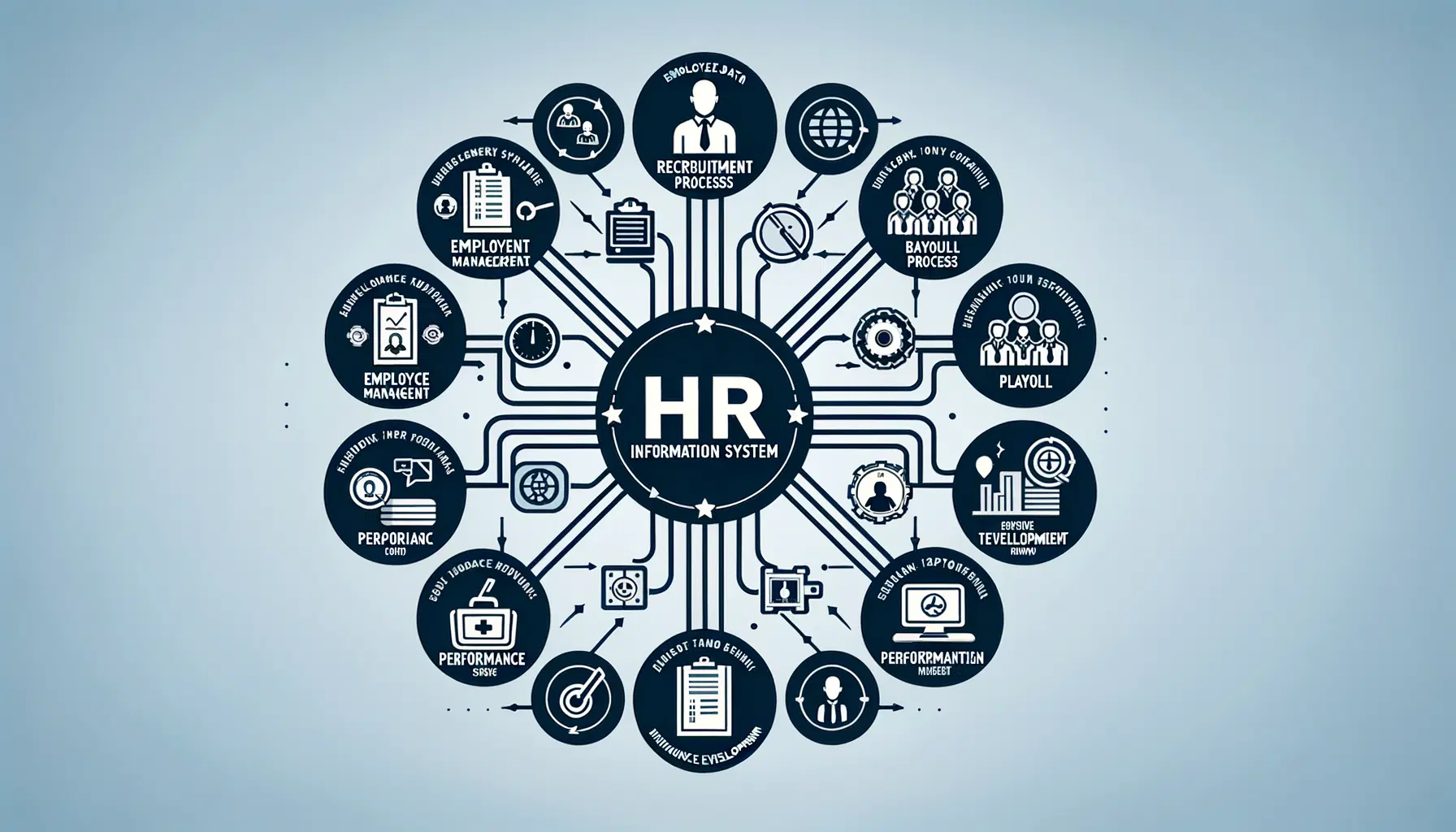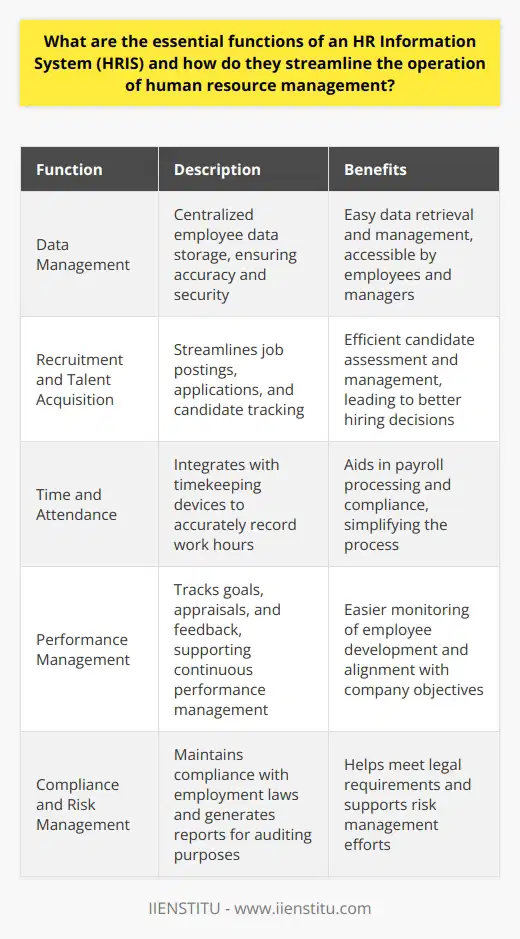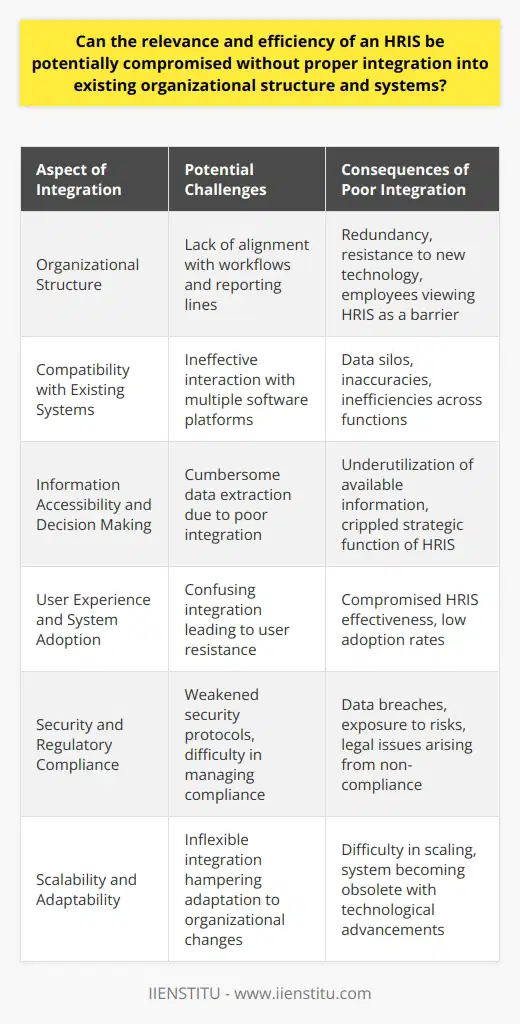
The human resources department is the backbone of any thriving organization, constantly balancing the dynamism of its workforce with strategic obligations. At the center of this balancing act is the Human Resource Information System (HRIS), an intersection of human resource management and information technology that aids in automatizing HR tasks and informing strategic business decisions.
HRIS magnifies the efficiency and effectiveness of HR departments by providing a centralized repository of employee data and a platform for executing HR processes. This blog post delves deep into the functionality and relevance of HRIS, endeavoring to explicate its components, significance, and the considerations for successful implementation within modern businesses.
Definition of HRIS
An HRIS encompasses integrated systems designed to help collect, store, manage, and interpret data related to human resource management. This data-driven approach towards HR processes embeds precision and strategic insight into routine HR activities.
Modern HRIS platforms may offer extensive functionalities; from tracking applicant workflows to managing payroll and benefits, creating an integrated ecosystem where data is the main driver for operative efficiency and decision making.
Brief history of HRIS
The evolution of HRIS aligns with the technological advancements transforming the business landscape. From simple databases designed to keep track of employee information, today’s HRIS have burgeoned into sophisticated tools that facilitate a wide spectrum of HR functions. Their development has progressed from manual systems in the 1970s, to client-server models in the 1980s, and now to cloud-based platforms that offer ubiquitous access and improved security measures.
Importance of HRIS in Modern Businesses
In the digital age, businesses are continuously seeking innovative ways to amplify their competitive edge and operational efficiency. HRIS has surfaced as a fundamental component in reconstructing the role of HR from administrative support to a strategic partner within the organization.
Streamlining HR operations
HRIS assist in the automation of mundane and repetitive HR tasks, freeing HR professionals to focus on more strategic activities. For instance, online courses with certificates can be managed with HRIS, allowing HR staff to track completion without manual input. Moreover, HRIS can automate payroll, attendance tracking, and benefits administration, thus significantly reducing the time and potential for errors inherent in manual processes.
Examples where HRIS makes HR operations efficient
Consider the implementation of an HRIS for leave management—a task that historically drained HR resources. With an HRIS, employees can apply for leave through a self-service portal, with workflows automatically routing requests to the appropriate manager for approval. Such systems often integrate with company calendars and email, providing instant notifications and updates, very much simplifying what used to be a complex manual task.
Accuracy in Employee Data Management
An HRIS is instrumental in maintaining precise employee data records, ensuring compliance with legal requirements and aiding in prompt decision-making. By eliminating manual data entry, HRIS enhance the integrity of employee data, which is crucial for sensitive tasks such as salary processing and performance evaluation.
Significance of accurate data
Inaccurate data can lead to costly mistakes, including compliance issues and budget overruns. An HRIS with quality controls ensures data accuracy, which is pivotal for analytics and reporting. HR managers can generate reliable reports at any time, drawing insights to guide business decisions.
Facilitating strategic decisions
HR training can be optimized through insights derived from data analytics within HRIS. HR departments can identify skills gaps and training needs, enabling them to design targeted development programs. Such data-driven decisions not only enhance individual performance but also contribute to the overall strategic objectives of the business.
Role of data in decision-making
Data within an HRIS serves as the empirical foundation for strategic decision-making. For instance, HRIS provide analytics that helps track turnover rates, employee engagement, and other critical metrics. By analyzing this data, HR professionals can forecast trends, develop retention strategies, and contribute to shaping organizational policy.
Key Components of an Effective HRIS
HRIS is not a monolithic tool but rather a suite of functionalities designed to address diverse HR needs. Each component plays a unique role in enhancing the operations and strategic capability of the HR department.
Employee Self-service
The ability for employees to access and manage their personal data without HR intervention is a salient feature of modern HRIS. Employee Self-service (ESS) empowers employees while also relieving HR staff from routine data entry and inquiries.
Explanation of Self-service feature
ESS enables employees to update personal details, apply for leave, access pay slips, and manage benefits online. This decentralization of information management fosters employee autonomy and reduces administrative workload for HR.
Performance Management
A comprehensive HRIS includes performance management tools that facilitate continuous feedback and goal setting. Through such systems, performance reviews become more objective, transparent, and aligned with business objectives.
Importance of tracking employee performance
Performance management within an HRIS enables the tracking progress against objectives, identifying high performers for rewards and recognition, and pinpointing underperformers for developmental intervention. This systematic approach to appraisals ensures fairness and drives employee motivation.
Recruitment and Application Tracking
A pivotal element of HRIS is the recruitment module, streamlining the talent acquisition process. By employing HRIS, organizations ensure that the recruitment practice is efficient, consistent, and aligned with organizational goals.
Role of HRIS in hiring processes
HRIS can encompass end-to-end recruitment solutions, starting from job posting to onboarding. They improve the reach of job postings, automate applicant tracking, screen candidates, and manage interview scheduling, thereby enhancing the overall recruitment efficiency.
Things to Consider When Implementing HRIS
Venturing into an HRIS implementation requires strategic planning and assessment. Organizations must approach this with a clear understanding of their current operations and future needs to reap the full benefits of the system.
Understanding Organization’s Needs
When considering an HRIS, it is vital to conduct a comprehensive needs assessment. This includes evaluating the effectiveness of the current HR processes and identifying areas where an HRIS could enhance functionality or address existing deficiencies.
Evaluation of current HR system limitations
Existing processes must be scrutinized for bottlenecks or inefficiencies that an HRIS might resolve. For example, if current methods for tracking hr training are cumbersome or error-prone, an HRIS could streamline these processes, centralize training records, and enhance compliance tracking.
Choosing Right HRIS Vendor
The selection of an HRIS vendor is a crucial step that should be approached with a clear understanding of the desired outcomes and the vendor's ability to meet them. A trusted partner with industry experience and a track record of successful implementations should be the goal.
Factors to consider when selecting vendor
Considerations such as ease of use, integration capabilities with existing systems, customer support, and after-sales service are essential when choosing an HRIS vendor. Security features and compliance with data protection regulations should also be top of mind.
Employee Training
Adequate training is the cornerstone of successful HRIS implementation. End-users must be proficient in navigating the system to maximize its utility and ensure a smooth transition from legacy systems.
Importance of user training in HRIS implementation
Proper training ensures that employees can fully utilize the capabilities of the HRIS, thereby reducing resistance to change and fostering adoption. It can also preempt many of the common challenges faced during implementation.
Common Challenges in HRIS Implementation and Possible Solutions
Even with the best planning, businesses may encounter challenges when implementing an HRIS. Identifying potential obstacles and their solutions is vital for a smooth transition.
Resistance to Change
Resistance from employees, often stemming from fear of the unknown or discomfort with a new system, can be a significant impediment to successful HRIS implementation.
Reason for employee resistance
Employees may worry about job security or struggle with adapting to new technologies. It's critical to address these concerns proactively by communicating the benefits of the HRIS and providing adequate hr training to ease the transition.
Data Security Concerns
With HRIS storing sensitive employee information, ensuring data security is paramount. Fears concerning privacy breaches are legitimate and must be mitigated through stringent security protocols.
Importance of data privacy in HRIS
Data protection laws and expectations from employees necessitate that an HRIS has robust security features. This includes encryption, secure access controls, and regular audits to prevent unauthorized data access and breaches.
A well-implemented HRIS is more than just a repository for employee information; it is a strategic tool that can reshape an organization's HR functions.
From streamlining operations to aiding in strategic decision-making, the importance and benefits of adopting an HRIS in modern business cannot be overstated. Organizations considering HRIS implementation should approach the process methodically, addressing potential challenges and ensuring the system aligns with the company's unique needs. As businesses continue to evolve, HR technology will play an increasingly vital role in maintaining competitive advantage and operational excellence.
Frequently Asked Questions
What are the essential functions of an HR Information System (HRIS) and how do they streamline the operation of human resource management?
Introduction
Human Resource Information Systems (HRIS) are essential. They transform HR operations dramatically. Such systems optimize human resource management efficiency. They provide robust platforms for managing employee data. Here we explore their core functions.
Core Functions of an HRIS
Data Management
HRIS allows for centralized employee data storage. Therefore, it makes data retrieval and management simple. It ensures data accuracy and security. Employees and managers access their information easily.
Recruitment and Talent Acquisition
An HRIS simplifies the recruitment process. It streamlines job postings, applications, and candidate tracking. Employers assess and manage candidates efficiently. This leads to better hiring decisions.
Employee Onboarding
Onboarding is vital. An HRIS automates this process. It ensures new hires integrate quickly. Staff receive necessary information without delay. The system tracks onboarding progress.
Time and Attendance
Tracking time and attendance becomes simple. Accurate work hours get recorded. An HRIS integrates with timekeeping devices. This aids in payroll processing and compliance.
Payroll Management
Payroll complexity reduces with an HRIS. It auto-calculates salaries, taxes, and deductions. Seamless integration with finance systems occurs. Payroll errors decrease. Compliance improves.
Benefits Administration
HRIS eases benefits management. Employees select benefits with ease. The system manages enrollments and changes. Costs and usage are trackable.
Performance Management
Performance reviews are streamlined. An HRIS tracks goals, appraisals, and feedback. It supports continuous performance management. Development of employees is easier to monitor.
Learning and Development
An HRIS supports training initiatives. It manages course enrollments and progress. Skill gaps are identifiable. It aligns learning with company goals.
Reporting and Analytics
Reporting turns into a quick task. An HRIS provides real-time data and custom reports. HR managers make data-driven decisions. Trend analysis and forecasting become accessible.
Compliance and Risk Management
An HRIS helps in meeting legal requirements. It maintains compliance with employment laws. Auditing functionality supports risk management. It generates reports for compliance purposes.
Employee Self-Service
Employees manage their personal information. They view payslips, request time off, and update details. This reduces administrative tasks for HR. It empowers employees.
Streamlining HR Management with an HRIS
An HRIS optimizes human resource functions. It eliminates repetitive tasks. HR professionals focus on strategic activities. Employee experience improves. Companies gain competitive advantages.
Operational consistency occurs across the HR spectrum. Errors diminish significantly. Data-driven insights foster better HR strategies. The HRIS becomes a single source of truth.
An HRIS is an indispensable tool in HR management. It enhances every aspect of HR operation. Companies leveraging an HRIS are better equipped. They face the complexities of modern HR with confidence.

How does the implementation of an HRIS impact the overall efficiency and productivity of an organization?
Introduction to HRIS
An HRIS, or Human Resource Information System, serves as a pivotal tool. It integrates human resource management with information technology. This fusion facilitates improved organizational operations. A well-implemented HRIS can significantly boost productivity. It also enhances overall efficiency.
HRIS and Organizational Efficiency
Streamlining Data Management
HRIS centralizes employee information. Data access and retrieval become simpler. Duplication of efforts reduces. This efficiency saves valuable time. Employees spend less time on data management. They focus more on strategic tasks.
Automating Administrative Tasks
Routine tasks no longer require manual input. Automation ensures precision. Updates occur in real time. HR professionals redirect their focus. They contribute to more valuable projects. Productivity increases as a result.
Enhancing Decision Making
An HRIS provides analytics capabilities. Leaders base decisions on solid data. They identify trends with ease. Informed decisions lead to effective strategies.
Facilitating Better Communication
HRIS features include employee self-service portals. These portals streamline communication. They empower employees. Staff resolve their own inquiries. They access essential information independently. This autonomy reduces HR workload.
HRIS and Organizational Productivity
Improving Talent Management
Recruitment processes become efficient with HRIS. The system tracks applicants methodically. It assists in hiring the best talent. An efficient onboarding process follows. Employees reach productivity sooner.
Fostering Employee Development
HRIS includes learning management systems. Employees access training easily. They keep skills current. Career development aligns with organizational needs.
Reducing Errors
Manual data entry invites errors. HRIS minimizes these errors significantly. Accuracy ensures compliance. It avoids costly legal issues. Reliability in operations increases.
Offering Strategic Insights
Real-time data from HRIS informs strategy. HR analytics uncover workforce insights. Leaders optimize talent allocation. Performance management aligns with goals.
An HRIS introduces profound efficiency gains. It enhances productivity across organizations. HR professionals leverage technology. They contribute more strategically. The entire workforce benefits. Informed decisions drive success. Automated systems support human talent. The HRIS serves as an essential facilitator. It propels organizations forward.

Can the relevance and efficiency of an HRIS be potentially compromised without proper integration into existing organizational structure and systems?
Understanding HRIS Integration
Organizations today increasingly use Human Resource Information Systems (HRIS). These systems promise efficiency and strategic insight. Their success, however, hinges on effective integration. Proper integration is crucial. It ensures HRIS fits within the larger business ecosystem.
HRIS and Organizational Structure
Organizational structure dictates workflows and reporting lines. HRIS can bridge gaps in communication. It can automate and streamline processes. Yet, lack of alignment can lead to redundancy. It may also create resistance to new technology. Employees need to see the HRIS as an enabler, not a barrier.
Compatibility with Existing Systems
Most companies operate on multiple software platforms. Seamless data flow is essential. HRIS must interact with these systems effectively. Poor integration can result in data silos. Integration challenges can cause inaccuracies. They can also lead to inefficiencies across functions.
Information Accessibility and Decision Making
Information drives decision making. HRIS offers a wealth of data. But, if poorly integrated, data extraction becomes cumbersome. This leads to underutilization of available information. It cripples the strategic function of HRIS.
User Experience and System Adoption
The user experience shapes system adoption. A user-friendly interface encourages use. Confusing integration does the opposite. This compromises the HRIS effectiveness. Proper integration aligns the HRIS with user needs. It promotes widespread adoption.
Security Concerns
Integration extends to security protocols. HRIS contains sensitive information. Without robust integration, security may weaken. Data breaches can occur. They expose the organization to risks.
Compliance Requirements
Regulatory compliance is mandatory. A well-integrated HRIS ensures adherence. It automates reports and maintains records. Fragmented systems struggle to manage compliance. Legal issues could arise.
Cost Implications
An HRIS demands significant investment. Failing to integrate properly can inflate costs. Costs may come from manual workarounds. They may also arise from fixing integration-related issues.
Scalability and Future-Proofing
Organizations evolve. HRIS needs to adapt to changes. Without flexible integration, scaling becomes difficult. Technological advancements may render the system obsolete.
Proper integration is non-negotiable. It ensures the relevance and efficiency of an HRIS. It aligns with existing structures and systems. It addresses security and compliance. It supports user adoption and scalability. Without it, the potential of an HRIS remains unrealized.



